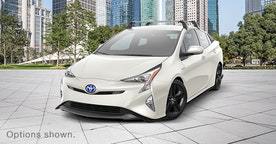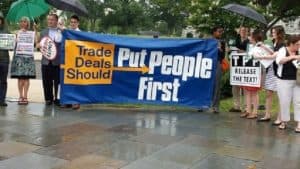
Toyota’s popular Prius hybrid would be one of many Japanese cars whose sticker price would rise if President Trump imposes tariffs on autos imported from Japan
Trade correspondent L.C. reports: President Trump threatened Japan with unspecified action over its persistent trade surplus with the US. The threat came in a telephone conversation with Wall Street Journal assistant editor James Freeman, who quoted the President as saying that the US has “good relations” with Japan but that he “is still bothered by the terms of US trade with Japan….[T]hat will end as soon as I tell them how much they have to pay.” The threat may reflect his intention to impose Section 232 (national defense) tariffs on Japanese car exports to the US. The President is similarly threatening Canada with ruinous tariffs on its US-bound automotive exports.
Freeman’s op ed was published under the title “Trump Eyes a Japan Trade Fight.” The President’s comment is consistent with his hard-line, belligerent approach to countries with whom the US runs a trade deficit, even when those countries are close military and strategic allies. Japan does have a large automotive trade surplus, and cars make up a large portion of Japanese goods exports to the US. Canada, however, doesn’t have a trade surplus with the US.
Japan key to US Pacific strategy
President Trump is also angry at Tokyo’s refusal to negotiate a bilateral free trade agreement (FTA). Instead, Japan has been calling for Washington to rejoin the Trans-Pacific Partnership (TPP), which would help thwart China’s efforts to bully Pacific nations. The US also needs Tokyo’s cooperation on the North Korea problem, the President’s new “Indo-Pacific” strategy for US engagement in the region, and the trilateral initiative of the US, Japan, and the EU to oppose China’s mercantilism and reform the World Trade Organization (WTO).
In other comments to reporters this week while traveling to a September 6th North Dakota fund-raiser, the President declared: “Look, everybody wants to deal with us. We’ve never had a president that dealt…. Japan would not deal with Obama. He [Prime Minister Abe] wouldn’t deal with President Obama. They [the Japanese] felt there was going to be no retribution. They felt [we] were weak and nobody was going to do anything.” The President then spoke of using the threat of automotive tariffs as leverage on trade. Car tariffs, he said, would cause some countries “ruination…. So every time I have a problem with any of these many countries… especially the big car countries,” the auto tariff threat is brought up.
These statements are vexing not only because the President declared himself willing to cause the ruination of allied countries but because they aren’t rooted in reality. Japan dealt extensively with Obama on trade, leading to the conclusion of the TPP, which was based in part on the bilateral autos-for-agricultural deal worked out over months of negotiations between the Abe and Obama governments.
Anti-Canada rhetoric escalates

President Trump can forget about the Teamsters vote in November if he kills NAFTA. The Teamsters don’t want a US-Mexico bilateral trade deal that leaves out Canada
As US-Canada ministerial talks continued this week in an effort to bring Canada into the new NAFTA deal (the “US-Mexico Trade Agreement”), the leaders of the two countries dug in publicly on their hard-line positions, and President Trump escalated his verbal belligerence toward Canada.
Speaking with reporters on a September 7th trip to North Dakota, the President made hostile comments about Canada and again threatened to impose automotive tariffs. “Canada has been ripping us off for a long time. Now, they’ve got to treat us fairly,” he said, “I don’t want to do anything bad to Canada. I can – all I have to do is tax their cars, it would be devastating….Actually, on some countries, including Canada, a tax on cars would be the ruination of the country. That’s how big it is. It’d be the ruination of the country. Now, they’ve taken advantage of us for many decades. We can’t let this happen anymore.” He insisted that whenever he raises he prospect of auto tariffs with certain counties, they give in and say “We’ll do it!…We’ll agree!” to his demands.
China: threat raised
President Trump also amplified his threats against China this week. On September 9th, he tweeted: “If the U.S. sells a car into China, there is a tax of 25%. If China sells a car into the U.S., there is a tax of 2%. Does anybody think that is FAIR? The days of the U.S. being ripped-off by other nations is OVER!”
The President’s facts are once again wrong. The US Most Favored Nation (MFN) car tax is 2.5%, not 2%, but was raised to 25% on China in the recent US tariff hikes – though China doesn’t actually export cars to the US. The reason why China’s tax on US cars is now actually 40% (25+15) – after having been lowered to 15% for other countries – is because China retaliated for the first tranche of US 25% tariffs on Chinese exports.
He continued, “’Ford has abruptly killed a plan to sell a Chinese-made small vehicle [the Focus] in the U.S. because of the prospect of higher U.S. Tariffs.’…. This is just the beginning. This car can now be BUILT IN THE U.S.A. and Ford will pay no tariffs!” This is also inaccurate. Ford has stated that it has decided, as a result of the new US tariff on Chinese cars, that the Focus won’t be sold at all in the US market. This is a blow to lower-income consumers since the availability of small, energy-efficient cars has been declining here.
Similarly, the President claims that slapping tariffs on Apple products assembled in China would force manufacturing back to the US. He tweeted on September 8th, “Apple prices may increase because of the massive Tariffs we may be imposing on China – but there is an easy solution where there would be ZERO tax, and indeed a tax incentive. Make your products in the US instead of China. Start building new plants now. Exciting!”
However, a large portion of the value of the iPhone and Mac computers is produced in the US. Forcing up the price of the end-product to consumers will mean fewer sales and a diminished market. But South Korea’s Samsung will be delighted that President Trump has handicapped its US rival.
The US advanced technology sector is also distressed at the escalating tariffs about to hit important intermediate tech goods made in China, warning of the harm that the proposed new tariffs will do to the US technology base. To the extent that Chinese President Xi’s goal is a China moving up the value chain to become self-sufficient in advanced technologies, the US trade measures reinforce his argument for doing so and force China to become independent of US technology.
Click here to go to the previous Founders Broadsheet (“In Afghanistan, It’s Deja Vu All Over Again”)

Leave a Reply